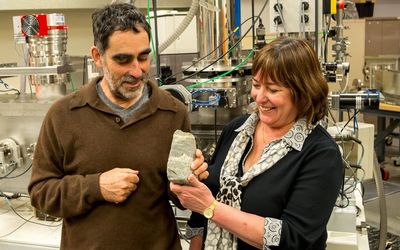Study reveals potato’s secret tomato heritage
Fossil aged 3.7-billion years builds case for life on Mars

SCIENCE ROCKS: Allen Nutman, left, of the University of Wollongong and Vickie Bennett of the Australian National University hold a specimen of the 3.7-billion-year-old fossils found in Greenland.
Life on earth is even older than we thought, according to Australian scientists who unveiled fossils dating back a staggering 3.7-billion years.
The tiny structures — called stromatolites — were found along the edge of Greenland’s ice cap after the melting of a snow patch. They are 220-million years older than the previous record-holders.
They proved that life emerged fairly shortly — in geological terms — after the earth was formed about 4.5-billion years ago, lead researcher Allen Nutman of the University of Wollongong said on Thursday.
And, he said, they offered hope that very basic life might at one point have existed on Mars.
“This discovery represents a new benchmark for the oldest preserved evidence of life on earth,” said Prof Martin Julian van Kranendonk, a geology expert at the University of New South Wales and a co-author of the findings, which have been published in the journal Nature.
“The structures and geochemistry from the newly exposed outcrops in Greenland display all of the features used in younger rocks to argue for a biological origin. It points to a rapid emergence of life on earth.”
The Isua stromatolites, which are 1cm-4cm high, matched other biological evidence on the evolution of the genetic code that placed the origins of life in a similar period, Nutman said.
Stromatolites are formed when micro-organisms, such as certain kinds of bacteria, trap bits of sediment together in layers. These layers build up over time to create solid rocks. The rocks themselves were never alive, but their existence shows the very simple single-cell organisms that made them were present on earth hundreds of millions of years earlier than previously thought.
Vickie Bennett from the Australian National University, who also worked on the study, said the research provided a new perspective and “turns the study of planetary habitability on its head”.
“Rather than speculating about potential early environments, for the first time we have rocks that we know record the conditions and environments that sustained early life.”
The discovery could help the hunt for life on Mars, which is considered the most likely location for microbial life-forms among other planets in the solar system. The research provides a new perspective and ‘turns the study of planetary habitability on its head’.












Leave a Reply
Be the First to Comment!
You must be logged in to post a comment.
You must be logged in to post a comment.